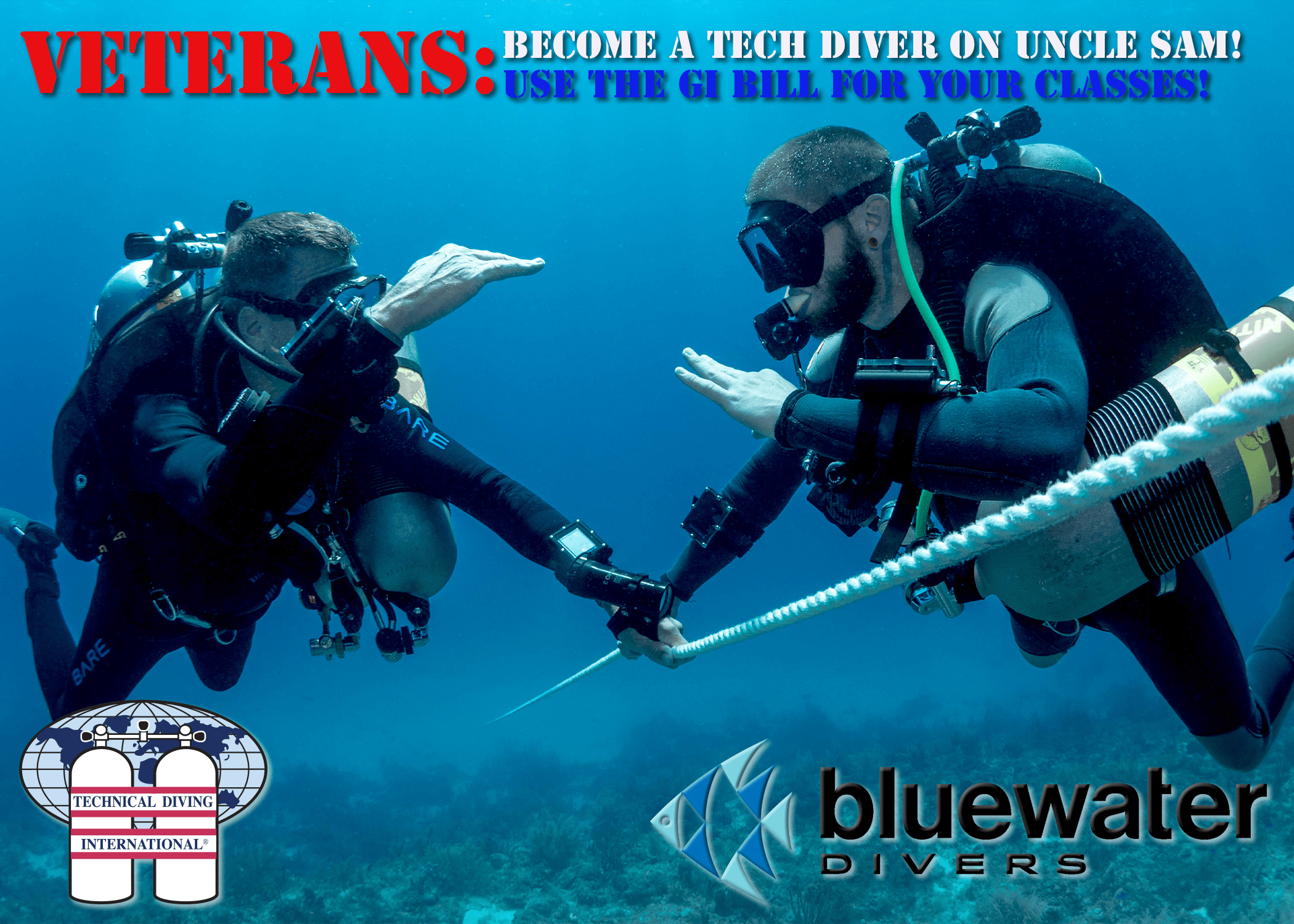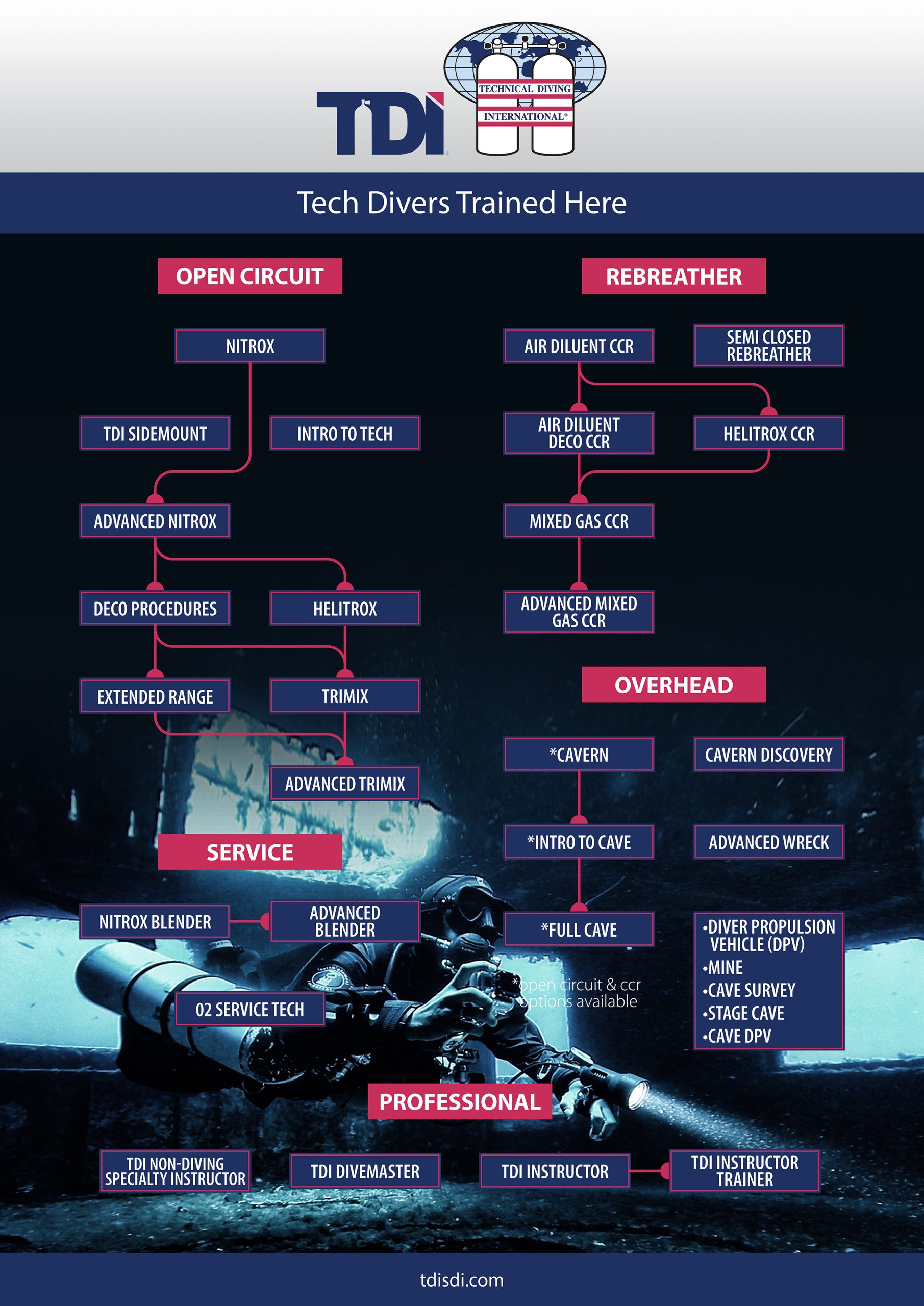Advanced Nitrox/Deco Procedures
Your Tech Journey Starts Right Here!
Serious Diving For Serious Divers!
Technical diving is not for everybody. It’s more dangerous than no-stop diving, involves lots of math, theory, and dive planning, and it requires you to buy a lot more gear. So, why is it for you? If you’re anything like me (meet your instructor), it was about two things: expanding my knowledge of dive and decompression theory far beyond that of recreational diving and being able to explore the wrecks that the vast majority of divers will never get to visit.
“Going deeper” just for the sake of getting a bigger number on your dive computer is NOT a proper reason for tec diving, and it’s how people get hurt. If that’s your motivation, stop now; tec diving is not for you. If, however, your goal is to grow your knowledge and skills far beyond their current status and learn to safely explore deeper dive sites through meticulous planning and preparation, this IS the avenue for you!
Please, carefully read all course information!
Overview:
This course is meant for recreational divers with experience making no-deco dives in doubles or sidemount who want to step into the world of decompression diving. If you do not have doubles experience, you’ll need to first take either the TDI Intro to Tec course or Sidemount Diver as a prerequisite. You will learn to plan and execute decompression dives to 150’, utilizing backmounted doubles (or sidemount) and decompression gases (Advanced Nitrox) to accelerate decompression. Proper planning includes planning for the inevitable failures and contingencies. This is the very heart of decompression diving.
Decompression diving is very equipment-intensive, and yes, it means you have to (get to) purchase even more expensive dive gear. Some of what you already own might work for deco diving, and some won’t. I am here to help answer any questions and get you into gear that will work for you and satisfy what you want to get out of your gear in the future. To plan and make these dives, you will learn the equipment you will actually need, how to make it easily accessible, how to make it work, and how to make it streamlined for carry and ready for use. Any gear I have that I’m not actually using at the time is yours to try, either before or during the course.
Don’t expect to be an “expert” decompression diver in the short time we’ll be together during this course. Instead, use the course as a foundation, and continue to build on that through practice, practice, practice. And don’t forget: “Practice does NOT make perfect. Perfect practice makes perfect.”
Prerequisites:
- Minimum age: 18
- TDI Intro to Tec or equivalent (OR proof of experience in chosen gear configuration)
- Advanced Open Water or equivalent
- TDI Nitrox or equivalent
- Proof of at least 25 open water dives (that’s TDI’s minimum; I really want you to have at least 50)
Administrative Stuff:
- TDI Liability Release – Download it, fill it out and sign it, then bring it to me either prior to, or the first day of, class.
- TDI Medical Questionnaire – Download it, fill it out and sign it, have your healthcare provider sign it, then bring it to me either prior to, or the first day of, class. This course requires a healthcare provider’s sign-off, whether you answered YES to any questions or not.
- Course cost: $1,500 – This includes all training, eLearning for both courses, and TDI certification fees.
- Dive Accident Insurance – Mandatory. If you don’t have DAN dive insurance yet, get it.
Paying your tuition is NOT a guarantee of certification. Technical diving is a lot of fun, BUT it is also serious business. You’re paying me to teach you, but YOU must earn the certification. With that in mind, I WANT you to succeed! That means I’ll gladly match any effort you’re putting into this class with my own. If we need to go another dive or two to get you fully prepared, that’s what we’ll do.
Course Breakdown:
- Two students to a class. No more, no less.
- Pay tuition, complete required forms, get checked out by your healthcare provider.
- Upon signup, you’ll get a welcome email with course info, eLearning codes, and supplemental study materials.
- Complete the online learning for both TDI Advanced Nitrox and TDI Decompression Procedures, including exams.
- Classroom/orientation session
- 2-3 open water dives in one of the local lakes (Tenkiller, Beaver, Blue Hole) depending on conditions
- 3-4 classroom sessions interspersed between dive days
- 4 ocean open water dives (or, preferably, no lake dives and all 6 in the ocean)
This course simply can NOT be successfully completed in Lake Tenkiller. Sure, you can get to 150′ in Tenkiller, but why would you?? It’s cold, pitch black, not enjoyable, not safe, and not conducive to learning. This is not the course to try to go cheap or “get by.” Doing that would be doing you a great disservice.
We will be traveling to one of two different locations to finish the course, depending on your configuration: Pompano Beach, FL, if you’re diving back mounted doubles or Roatan, if you’re diving sidemount. That means you’ll need to figure travel/lodging/food costs into your budget. It also means that you will be properly prepared to do REAL deco dives in the correct environment.

Required Equipment:
- Mask – Fit, comfort, and low volume are most important.
- Backup Mask – You must have a backup mask and a way to carry it. Tec shorts, glue-on thigh pockets, and sidemount butt pockets are good choices.
- Fins – Short, wide fins with plenty of propulsion work best (Jetfins, RK3s, etc). Please, leave your split fins at home.
- Cylinders – Steel, backmounted, manifolded doubles with an isolator are the industry standard for serious technical diving. You’ll need cylinders with volume appropriate for dives to 150′ considering your individual SAC rate. If you’d prefer to do this course in sidemount, that’s cool too. Just get properly trained in their use first. Cylinders need to be marked according to TDI standards, and Nitrox cylinders need to be marked Nitrox. An oxygen-clean deco gas cylinder rigged to carry is also required. AL40s and AL72s are the most common. I have ones you can rent if you don’t have your own yet.
- Regulators – You’ll need at least 3 regulators (1st and 2nd stage), a primary and a primary backup for your back-gas cylinders and one oxygen-clean regulator for your deco gas. Your right-hand primary second stage needs to be on a long hose (6-7′). In addition, you need an SPG on your back-gas supply and an SPG on your deco gas. These regulators all need to be DIN connection, not yoke. If you already have regulators that you really want to use during this course, see if they can be converted. DIN is simply a much better connection. It handles higher pressures than yoke, its o-ring is encapsulated, and in case of an impact to the tank valve, there’s no knob to break off. A yoke connection is something we simply can’t take a chance with at 150′.
- Backplate – Can be either aluminum or steel. I prefer steel to cover all bases. If you plan to deco dive in just a wetsuit and don’t need much weight, you can probably get by with the aluminum. If you plan to do much drysuit deco diving, you definitely want the steel. A simple, continuous webbing harness is the best choice also. You really don’t want 100+lbs. of doubles relying on those little Fastex fasteners on the “deluxe” style harnesses, do you?
- Wing – A wing appropriate for doubles will be in the 45-60 lb. lift range. And 45 lbs. lift is really all you need for most dives. One important aspect to consider is a wing with a redundant bladder. In the unlikely event of a bladder failure at 150′, you need a backup plan quickly. A dual-bladder wing is the best option in this instance. Without a dual-bladder wing, your only other options are your drysuit or a lift bag/SMB for alternative buoyancy. If you’re going to be tech diving in sidemount, there are good options for BCs with redundant bladders as well.
- Dive Computer – A Shearwater computer is mandatory for this course, preferably a Perdix or Petrel. The Teric is fine as a backup, but it is not ideal as a primary. You will also need a backup computer or depth gauge, timing device, and printed dive tables. Shearwater computers are not only the best on the market (in my humble opinion), but they also have features that are indispensable in teaching, learning, and making deco dives. We’ll download previous dives in the classroom and go over each step of the dive.
- Dive Planner – You need a way to plan your dives in detail. The algorithm of your planner should match the algorithm of your dive computer, and we will use Bühlmann ZHL16-C with Gradient Factors (GF). I like MultiDeco and V-Planner for my laptop. I’ve had good luck with Baltic on my iPhone. Download your choice, and plan a few dives using different gases, depths, and times. Remember that run times are how we plan deco dives!
- Lights – At least a primary and a backup. At least. And make sure they’re charged or have fresh batteries.
- DSMB – Use what you already have if you like, but the open-bottom kind are the best. You can fill them from your wing and have almost no effect on your buoyancy. We’ll practice this technique in the course.
- Spool – For releasing your DSMB. Whatever you already have is “probably” good enough, but we’ll check it out and see. I prefer the Akona aluminum finger spools. They’re just as good the Apeks, have better line, are much cheaper, and I worked with Akona to develop them! 🙂 If you prefer to use one of those big, clunky wreck/cave reels, knock yourself out.
- Cutting Tools – At least one knife and a backup. At least. And make sure they’re sharp and well-stowed.
- Slate and Pencil – You’ll need a slate to jot down bottom time, run time, @+5, stops, gas switches, etc. Wrist slates are the most popular by far, but bring whatever works best for you.
- Jon Line – Very handy during anchor-line deco. You can buy one or make one.
- Double-ended Bolt Snaps – Never a bad idea to have a couple of these on you at all times.
- Exposure Protection – Whatever the environment calls for. Remember that you’re more likely to get cold on a decompression stop because you’re not moving much.
*** I will always err on the side of safety. Whether that means calling/postponing a dive due to weather, other unfavorable dive conditions, or something I don’t think you’re ready for yet, I’d rather have you mad at me than bent or dead. ***
What To Expect:
Click each button for TDI’s Standards & Procedures for each course.


